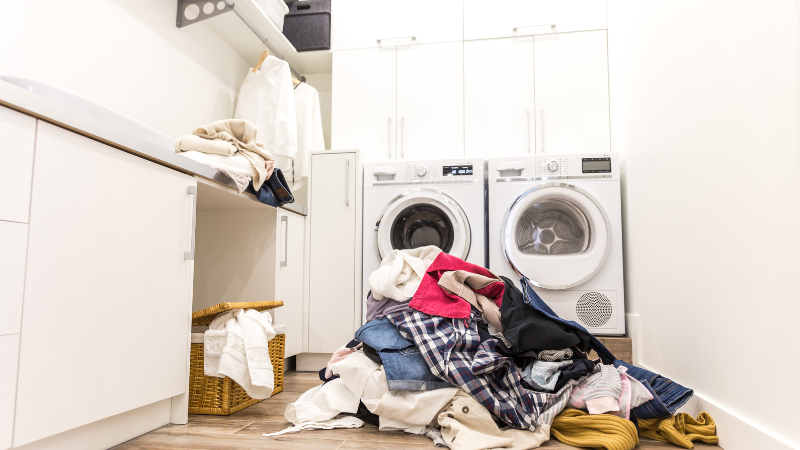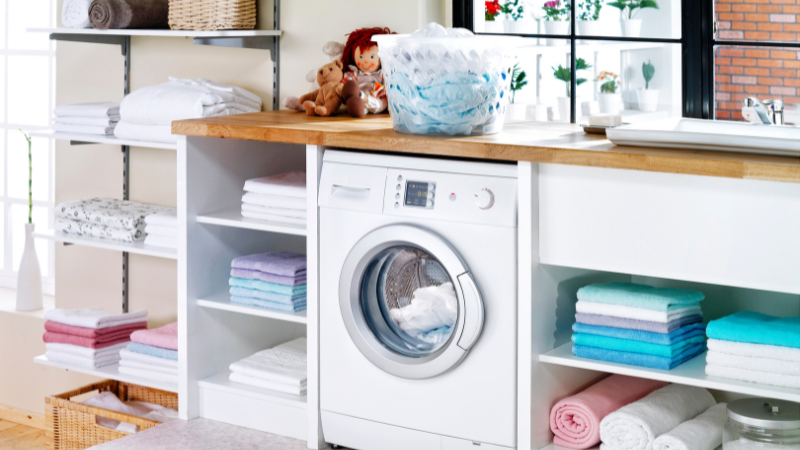A laundry room appears to be sparkling clean—after all, laundry gets done in there. In reality, the typical laundry room can be the perfect breeding ground for mold colonies. When doing laundry, it’s important to give due consideration to the laundry room itself to keep it mold free.
Table of Contents
Why does mold grow in the laundry room?
Mold thrives in areas with high humidity levels, plentiful organic materials, and darkness. The laundry room offers mold spores all three forms of nourishment. Humidity is released from the dryer; dirt particles are embedded in clothes; and a closed hamper provides a cozy nook for mold spores to flourish.
The washing machine, too, is a source of water—an important food source for mold. When the appliance leaks, moisture is released and feeds the mold. Due to wear and tear, pipes in the laundry room can spring a leak, giving mold spores a reason to colonize the area.
The hamper, too, can invite mold, especially when damp towels or sweaty gym clothes are tossed into it. Neglecting to launder the damp materials for extended periods can lead to a nasty outbreak of mold developing inside the hamper. Mold can spread quickly to the rest of the laundry room.
How to keep your laundry room mold free
If you have a laundry room in your house, it’s important that you take the proper precautions to ensure that area stays mold free. After all, mold can cause serious problems for you and your family. Don’t overlook this issue, because doing so could cost you thousands of dollars.
1. Lower humidity levels
Keeping the laundry room mold free requires following the below-mentioned steps on a routine basis. Reduce the humidity level inside the laundry room. Between 30 and 50 percent is an ideal setting, as it helps prevent mold (but does not kill mold) and keeps the dryer from overworking.
Take moisture control a step further by installing a dehumidifier inside the laundry room. The dehumidifier will significantly reduce humidity and give mold spores less moisture to feed on. Consider a dehumidifier model that will run continuously for optimal results.
2. Inspect for water damage
As mentioned, mold spores thrive in moisture-rich spaces. Due to this reason, it is important to routinely check the laundry room for signs of water damage, like discolored walls or damp drywall around the pipes. If water damage is suspected, repair the issue as quickly as possible to deter mold.
3. Clean the washer
While the washing machine launders clothes, it fails to clean itself. Maintaining the washer is important. Moisture can linger around the door and rubber seals; cleaning these areas regularly is key to preventing mold. Follow the manufacturer’s instructions for properly cleaning the appliance.
4. Clean the dryer
While mold growth inside the dryer seems like an impossibility, the buildup of lint inside it can trigger a mold problem. An unclean lint trap prevents moisture from escaping through the vent unobstructed. Ensure the dryer is vented to an outside vent with an approved rigid dryer duct.
Inspect the dryer duct on a routine basis, making sure it is attached securely to the dryer and remains lint-free. Feeling air around the dryer duct while it is in operation indicates that holes are present and leaking moist air. In such cases, replace the duct as soon as possible.
5. Dry clothes promptly
Leaving wet clothes inside an enclosed area, like a washing machine, creates a moisture-rich space—a hospitable environment for mold spores. Prevent a growing infestation of mold colonies inside the washing machine by drying clothes immediately after the wash cycle is complete.
6. Ventilate the laundry room
A well-ventilated laundry room will help keep the area mold free. The HVAC system can aid in increasing ventilation. Alternate methods that effectively increase ventilation include opening windows and doors while the washing machine is in use. Also consider running a powered fan in the area.
7. Avoid storing damp clothes
Promptly laundering damp clothes inside the hamper will help prevent mold from growing inside the laundry room. Doing frequent loads of laundry squashes the humidity found in piles of dirty laundry and cleans the dirt from clothing that can be an ideal food source for mold spores.
8. Use desiccants
Commercial drying agents, also known as desiccants, absorb moisture from the air. Place desiccants throughout the laundry room to help draw out excess moisture and avoid giving mold the moisture it needs to multiply. Keep the desiccants out of the reach of children and pets.
Smelling musty odors inside the laundry room means that mold has taken hold. A solution of water and chlorine bleach can be used to clean the laundry room. Wipe down all surfaces inside the laundry room with the solution, including those that do not show visible signs of mold growth.
After the existing mold is removed, clean the laundry room on a weekly basis to prevent mold growth from recurring. Antibacterial sprays or cleaning products can be used regularly to keep the mold at bay. Replace moldy drywall and wood trim in the laundry room to eliminate the infestation.

Find a professional mold removal company
Mold colonies thriving inside the laundry room are a dangerous event, since the spores can easily spread to and contaminate other parts of the home. When you stumble upon a mold problem, consult the mold remediation experts at ServiceMaster by Replacements. We’ll eliminate the mold problem fast.
Our mold cleanup technicians are highly experienced in removing mold from homes and businesses safely and efficiently. We handle mold remediation every day, utilizing infrared technology that detects spores growing even in hidden areas, such as behind walls, under carpets, and beneath wallpaper.
Isolating the infested areas is done to prevent airborne spores from contaminating other parts of the building. Using safe and effective chemicals, our specialists eliminate all traces of mold. Structural damage caused by mold is repaired, and a final testing is done to ensure the home is mold free.
Prevent dangerous structural instability and ill health by contacting ServiceMaster by Replacements for prompt, professional mold remediation. Our skilled crews are proud to serve homes and commercial buildings in New Jersey, 24 hours a day, 7 days a week.
Call us today at (732) 842-6917 for quality mold removal services.







